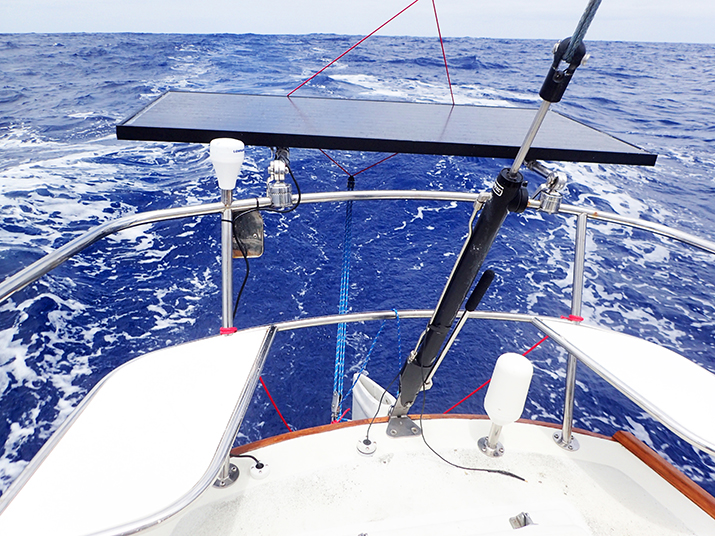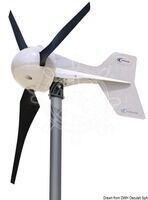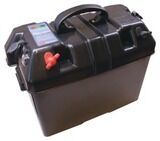| HOW TO USE SOLAR PANELS? |
 |
 |
Photovoltaic solar panels are a good way to replenish the DC power in your boat’s battery system. Small panels maintain or trickle charge batteries while you’re unplugged from shore power. Larger panels also charge batteries, and produce enough energy to power appliances, like an inverter used for producing household-type AC power.
Who Can Use Solar Panels?
Small boats: A solar panel can keep the battery fully charged when the boat is on the trailer, at a mooring or sitting at her slip. All batteries self-discharge, and a small panel can eliminate the problems caused by dead batteries. Since solar panels put out pure DC power, they are excellent chargers as long as they have a regulator in the circuit when they require it (see below).
Cruising and racing sailboats can use solar panels to augment or replace their other charging sources. Many sailboats that go on long passages have to use their propulsion engine for 1 to 2 hours per day to charge batteries and replace the energy that’s been consumed. With a couple of solar panels installed, these boats can often extend their time between engine uses by a day or more. Truly efficient solar-equipped boats may not have to use the engine for charging at all.

How much energy do you want to generate?
Solar panels charge 12V batteries, and might have a voltage of 20V with no battery in the circuit, but are engineered to provide their power at the voltage a 12V battery requires for full charging.
Panels are measured in either Watts, or Amps, or both. We rate them in Amps, since most boaters have an idea of how many amp-hours their battery capacity is, or how many amp-hours they use in a day while cruising. We also use a simplifying assumption, and that is the panel will put out its maximum output for five hours a day. As they say in the car commercials, “your mileage may vary,” but this rule of thumb works well for estimating a panel’s output.
We arrive at these values by averaging the number of hours the panel spends in full sun (defined as 1000 watts of energy per square meter). Full sun means enough light so you see fairly sharp-edged shadows (most locations get no more than 80 to 85% of full sun). In most of the Europe. the amount of time a panel spends in full sun averages four or five hours per day.
Do you need a charge controller?
As a general rule panels that produce less than 1.5% of a battery’s rated capacity in amp hours don’t require regulation. This means that a 1.5A panel is the largest you should use without a regulator on a 100Ah battery. Regulators should generally be used any time you have two or more large panels connected to your batteries.
If you’re concerned about damaging your new gel or AGM batteries due to overcharging, you can add a small, inexpensive charge controller. These controllers, also called regulators, are rated by the maximum number of amps in your solar array, and we offer versions handling between 5A and 20A. Regulators are ideal if you can’t be onboard to monitor your electrical system, and the top units now feature smart, multi-stage charging.
Types of solar panels
Two types of panels use either silicon crystals or thin chemical films to generate electricity.
Mono-crystalline and multi-crystalline (c-Si) panels are the oldest technology and also the most powerful. When sized correctly and matched to appropriate batteries, these are the panels to use for running large DC loads such as lights, a TV, radio or Navigation systems. Our current assortment of this type includes single-crystalline products from ENECOM.
In crystalline panels, silicon, the primary material in quartz sand, is grown into crystals, refined, purified (by an expensive process), sliced into thin wafers and “doped” with the addition of chemicals. Solar cells create electrical current, the quantity determined by the size and efficiency of the cell and the amount of light. Solar modules are created by connecting cells in parallel to increase amperage and in series to increase voltage. Typical solar modules have 30 or 36 cells (generating between 14 and 18V DC).
Amorphous thin film Silicon (a-Si) panels are only about 50% as efficient as multi-crystalline panels, but can be manufactured in flexible forms so they can roll or fold, or conform to the shape of a cabintop. They are more efficient in low or diffused light conditions and are less subject to voltage drops when they heat up.
They’re the panels most often used for low amperage charging and battery maintenance. They don’t generally have enough output for serious energy replenishment, but can be used to “float” or trickle charge a battery.
The PowerFilm solar powered battery chargers represent this type of economical solar cell. So-called “Single Junction” panels of this variety have the fewest number of layers of chemical coatings deposited on their metal plates.
Thin film panels require lower manufacturing costs than c-Si panels like the ENECOM panels (with 45% of crystalline panel cost coming from making the raw silicon crystal structure).
Simple rules for best power production
Keep the panels as perpendicular to the incoming sun’s rays as possible. We understand that if you’ve mounted panels on a boat on a mooring, you may not be able to guarantee that they are pointing towards the sun, but all panels will produce more power if they get direct sunlight. This is a compelling reason to mount panels on cruising boats so that they can be aimed in the appropriate direction, no matter what the season, course, or latitude.
Products
WIND GENERATOR, LE-300 MARINE, 300 W, 24 V
12.209.24
BATTERY BOX, WITH USB AND LIGHTER SOCKETS, 340 x 195 x 230 mm
M14016000
|

